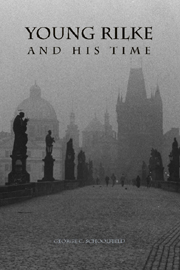Book contents
- Frontmatter
- Contents
- Preface
- Acknowledgments
- List of Abbreviations
- Chronology
- I Prague
- II Diaries
- III Rilke as Literary Critic
- IV Poems
- 8 “Der alte Invalid”
- 9 “Auswandrerschiff”
- 10 “An den Grafen von Platen”
- 11 “Die Liese wird heute just sechzehn Jahr”
- 12 “Venedig”
- 13 “Weißes Glück”
- 14 “Aus einem Bauernsommer” and “Vom Tode”
- 15 “Intérieur”
- 16 “In der Certosa”
- 17 “Die Heiligen Drei Könige”
- 18 “Aus dem hohen Jubelklanggedränge” and “Im Musiksaal”
- 19 “Karl der Zwölfte von Schweden reitet in der Ukraine”
- 20 “Sturm”
- Select Bibliography
- Index
19 - “Karl der Zwölfte von Schweden reitet in der Ukraine”
from IV - Poems
Published online by Cambridge University Press: 05 February 2013
- Frontmatter
- Contents
- Preface
- Acknowledgments
- List of Abbreviations
- Chronology
- I Prague
- II Diaries
- III Rilke as Literary Critic
- IV Poems
- 8 “Der alte Invalid”
- 9 “Auswandrerschiff”
- 10 “An den Grafen von Platen”
- 11 “Die Liese wird heute just sechzehn Jahr”
- 12 “Venedig”
- 13 “Weißes Glück”
- 14 “Aus einem Bauernsommer” and “Vom Tode”
- 15 “Intérieur”
- 16 “In der Certosa”
- 17 “Die Heiligen Drei Könige”
- 18 “Aus dem hohen Jubelklanggedränge” and “Im Musiksaal”
- 19 “Karl der Zwölfte von Schweden reitet in der Ukraine”
- 20 “Sturm”
- Select Bibliography
- Index
Summary
On their first visit to Moscow, in April 1899 Lou and Rilke, both art lovers, had found the museums closed for Easter, but when they returned in May, they went to the Tretyakov Gallery, among others; Rilke was captivated by a large display of works by Viktor Michailovich Vasnyetzov (1846–1925). These included “After the Battle of Igor Against the Polovtsians,” “The Werewolf,” “Ivan the Terrible,” and “Three Knights,” or “The Bogatyrs,” as well as a number of sketches for the murals in the Cathedral of St. Vladimir in Kiev, which they would visit a year later. Rilke was particularly impressed by “After the Battle”; in his essay, “Russische Kunst,” started in January 1900 and finished in the summer of 1901, he allotted a central passage to the post-battle painting:
ein weites Totenfeld, auf den Waffen und Helmen breiter, gefallener Bojaren Blut und Abendrot. Mitten unten den in Trotz und Zorn Verstorbenen ein blauer, blonder Prinz, wie eine einzige blasse Blüte in den Ranken des Todes. Fern, fern am Horizont eine Faust und der schlanke Bug eines Bogens vor dem Himmel und in der schweren schwankenden Luft, wie Schreie, zwei große, schwarze, raufende Raubvögel.”
(SW 5:500)[a farflung field of death, on the weapons and helmets of broad, fallen boyars blood and sunset. In the midst of those perished in defiance and anger, a blue, blond prince, like a single pale blossom in the toils of death. Far, far away on the horizon a fist and the slender arch of a bow against the sky, and in the heavy, hovering air, like shrieks, two great black birds of prey, fighting.]
- Type
- Chapter
- Information
- Young Rilke and his Time , pp. 362 - 387Publisher: Boydell & BrewerPrint publication year: 2008



